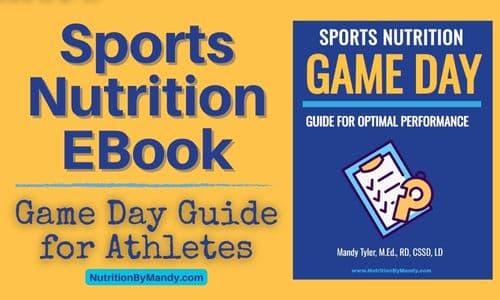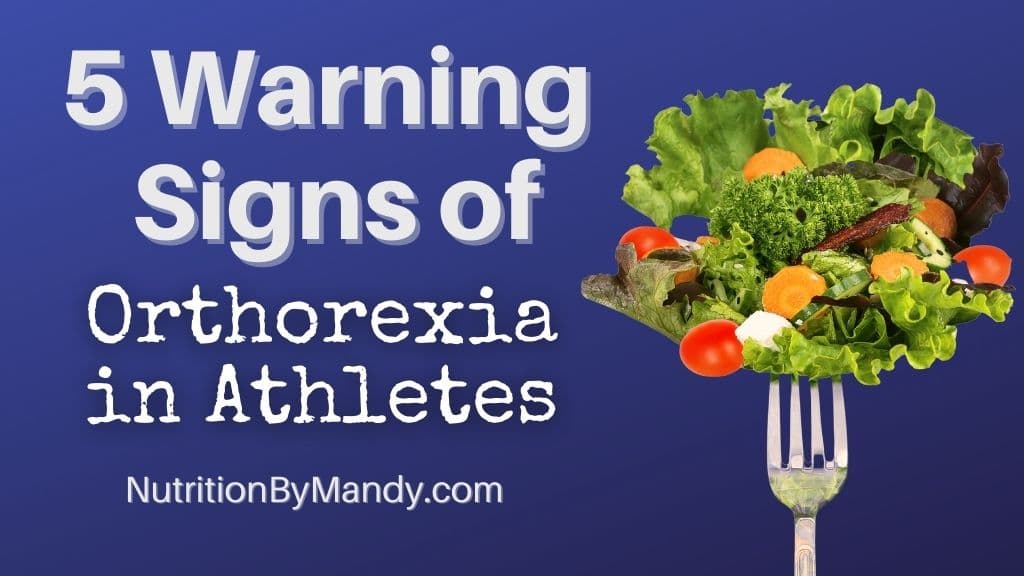Last Updated on July 2, 2025 by Mandy Tyler, M.Ed., RD, CSSD, LD
5 Warning Signs of Orthorexia in Athletes
It is important for parents, coaches, and athletic trainers to be aware of the warning signs of orthorexia.
Let’s take at what orthorexia is. Then we will examine 5 warning signs of orthorexia in athletes.
What is Orthorexia?
The term orthorexia nervosa was first used in 1997 by Dr. Steven Bratman. He used this term to describe individuals with an extreme fixation on eating healthy (1).
Since this time orthorexia has become a widely used term to describe a condition in which individuals become fixated on healthy eating.
Despite orthorexia being a widely recognized condition (2), orthorexia is not identified as a diagnosed eating disorder.
Due to this, there is no defined diagnostic criteria for orthorexia. Thus, it is hard to truly estimate how many individuals have this condition (3).

Is Orthorexia the Same as Healthy Eating?
Orthorexia is not the same as just wanting to eat healthy. Many athletes desire to eat healthy to improve performance.
However, athletes demonstrating characteristics of orthorexia have developed an obsession with healthy or clean eating.
This fixation on healthy eating can lead to inadequate energy and nutrient take, negative impacts on health, as well as social isolation (4).
Is Orthorexia the Same as Anorexia?
Orthorexia is not the same condition as anorexia. Anorexia nervosa is a diagnosed eating disorder.
Anorexia is characterized by restricted energy intake, an intense fear of gaining weight, as well as a disturbance in the way one’s body weight or shape is experienced (5).
Unlike anorexia, orthorexia is focused more on the quality of food being eaten rather than the quantity (6). In addition, while anorexia is related to body image concerns and a fear of gaining weight, this is not always the driving factor in orthorexia (3).
However, similar to anorexia, the restricted food intake can lead to calorie and nutrient deficiencies and negative impacts on health.

Is Orthorexia a Concern for Athletes?
Athletes demonstrating signs of orthorexia is a concern. Restriction of food intake resulting in a calorie or nutrient deficit can impact the athlete’s health as well as sports performance.
Athletes often expend a high number of calories through practices, competitions, strength training and conditioning, as well as normal daily activities.
When daily caloric expenditure exceeds dietary intake of calories from foods and beverages an imbalance occurs.
We refer to this imbalance of calories as Relative Energy Deficiency in Sport or REDs (7).
Relative Energy Deficiency in Sport (REDs)
REDs is associated with a syndrome of health concerns that can have negative impacts throughout the body. In addition, the caloric imbalance can negatively impact sports performance (7).
Thus, the disordered eating patterns associated with orthorexia, which contribute to calorie imbalance and underfueling, are a concern for athletes.

What are 5 Warning Signs of Orthorexia in Athletes?
Now that you have an overview of what orthorexia is and how it can impact an athlete’s well-being, let’s take a look at 5 warning signs for orthorexia in athletes.
#1 Extreme Fixation on “Healthy” Food
Athletes displaying an extreme fixation on only eating “healthy,” “clean,” or “pure” foods is a key warning sign for orthorexia. It is important to note that the terms “healthy, clean, and pure” are based on the athlete’s perceptions of health.
You may observe an athlete obsessed with reading nutrition fact labels and ingredient lists. The athlete may follow numerous blogs or social media accounts focused on clean or healthy eating (3).
In addition, the individual may spend a large amount of time researching food, added ingredients, and meal preparation methods.
The athlete may also place excessive focus on what teammates are eating and be judgmental of others food choices. You may observe the athlete making comments about eating a healthier or superior diet compared to others (4, 8).

#2 Elimination of Foods or Food Groups
As an athlete becomes fixated on only consuming “healthy” foods, other foods that the individual deems are unhealthy will be removed from the diet.
This may start out with the removal of a specific type of food or ingredient from the diet. As the athlete becomes more restrictive, it may extend to an entire food group.
Development of Food Rules
The athlete may develop strict food rules for what is or is not considered “healthy” or “pure.”
Example food rules may include (3, 4, 6, 9):
- No dairy
- No red meat
- No animal products
- No added sugars, saturated fats, refined carbohydrates
- No artificial colorings or preservatives
- No pesticides or genetically-modified ingredients
- Only purchasing locally grown produce
- Order foods should be eaten in or combined at meals
- Specific methods used for meal preparation
- Type of equipment used in the meal preparation process
It is important to note the rules are developed with a focus on eating healthy and not related to religious observations nor environmental concerns (4).

#3 Avoidance of Team Events Involving Food
As individuals become more fixated on eating only “healthy” foods, they may start to avoid social situations involving food.
For athletes, team events involving food may provoke a great amount of stress and anxiety. The athlete may ask numerous questions about what food will be served at the event and how it will be prepared.
You may observe an athlete avoiding team events involving food. If the athlete cannot avoid attending, the individual may bring their own food to the event (9).
The athlete may also bring their own food for pre- and post-game meals instead of eating what is provided for the team.
#4 Excessive Amount of Time and Money Spent on Preparing Food
As rules become more stringent about what healthy foods are allowed in the diet, the amount of time required to prepare food may grow.
Individuals may be unwilling to eat at restaurants and may spend large amounts of time preparing meals (6). The time required to prepare food can interfere with school and team activities, thus further contributing to social isolation.
In addition to time, individuals may spend a large amount of money at health food stores to buy only “clean” ingredients. Of note, the amount of money spent may be well over what their budget can handle (6).
#5 Feelings of Guilt
The 5th warning sign of orthorexia is an athlete expressing feelings of guilt for eating foods deemed unhealthy.
The athlete may express fear that eating the unhealthy food will impact their physical health and/or performance.
If the athlete eats something viewed as unhealthy, the individual may compensate by creating more strict food rules (9).
This can lead to further foods being eliminated from the diet and increase the risk of nutrient deficiencies.

Seek Help for Athletes Showing Warning Signs of Orthorexia
If you suspect an athlete is showing signs of orthorexia or disordered eating it is important to seek help for the athlete.
The disordered eating patterns associated with orthorexia can lead to a caloric imbalance, negatively impacting the athlete’s health and performance.
In addition, athletes with orthorexia are an increased risk for the development of a diagnosed eating disorder (10).
Consult with a Sports Dietitian Nutritionist
Athletes with disordered eating behaviors can benefit from meeting with a sports dietitian nutritionist.
A sports dietitian is a key part of the treatment team, working alongside a mental health professional to address the specific health and nutrition concerns of the athlete.
5 Warning Signs of Orthorexia in Athletes
You now have an overview of the 5 warning signs of orthorexia that parents, coaches, and athletic trainers need to be aware of.
For additional sports nutrition information, check out my blog on nutrition strategies to support teen athletes.
Join the Nutrition By Mandy Email List & Get a Free Weekly Meal Planner Template
Click HERE to join the Nutrition By Mandy e-mail list. When you join you will receive a free weekly meal planner template to download and plan out your meals for the week.
About the Author
Mandy Tyler is a Sports Dietitian Nutritionist in the San Antonio, TX area. She is a Registered and Licensed Dietitian, a Board-Certified Specialist in Sports Dietetics, a Licensed Athletic Trainer, and is a Certified Exercise Physiologist through the American College of Sports Medicine. Mandy has experience working with athletes at the high school, collegiate, and professional levels. She believes the key to reaching one’s full potential, both in everyday life and in sports performance, relies on a healthy nutritional foundation.

If you are looking to take your performance to the next level, make sure to check out my new Sports Nutrition Game Day Guide. This downloadable guide is written to help athletes develop an individualized plan to achieve peak performance on game day.





